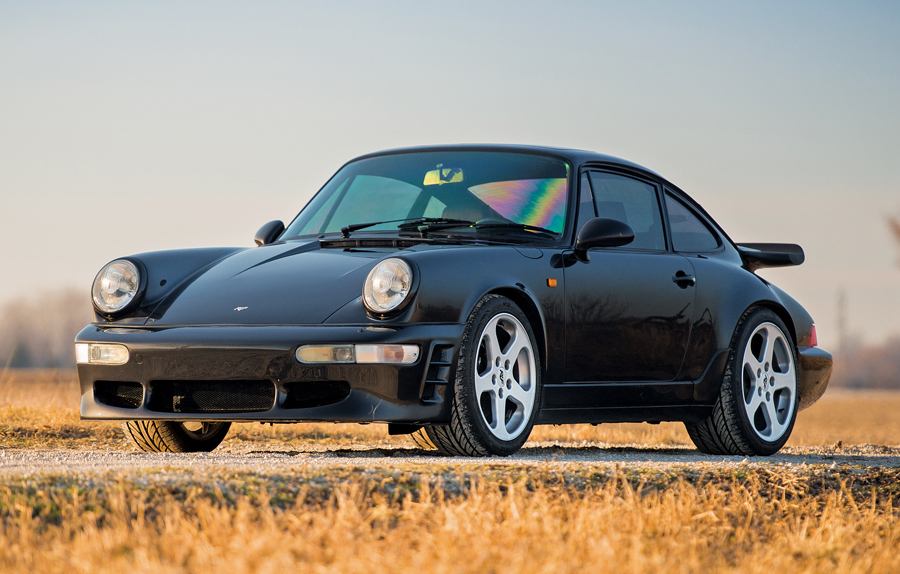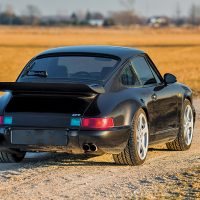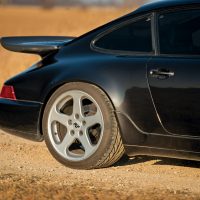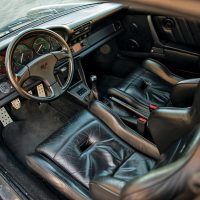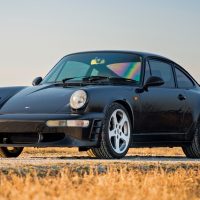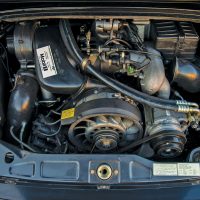- Nicknamed the “Black Devil”
- One-off custom order by RUF’s Japanese importer
- Signed and inscribed “Diablo Negro” by Alois Ruf Jr.
- Features Porsche Classic in-dash navigation system and custom car cover
SCM Analysis
Detailing
| Vehicle: | 1991 RUF CR4 “Black Devil” |
| Years Produced: | 1990 |
| Number Produced: | One |
| Original List Price: | Unknown; however, it was likely about $325,000 |
| SCM Valuation: | $201,000 (this one-off car) |
| Tune Up Cost: | $2,000 with valve adjustment |
| Chassis Number Location: | Stamping under hood on crossmember in front of and just under the gas tank, metal plate on passenger’s side in side fender |
| Engine Number Location: | Vertical fan support, driver’s side, facing left |
| Club Info: | Porsche Club of America |
| Website: | http://www.pca.org |
| Alternatives: | 1990 Mercedes-Benz 190E Evo II, 1992 Porsche Carrera RS, 1988–92 Ferrari F40, RUF CTR “Yellowbird” |
| Investment Grade: | B |
This car, Lot 153, sold for $201,600, including buyer’s premium, at the RM Sotheby’s Amelia Island, FL, auction on March 8, 2019.
The next generation of car collectors is here, and they have their own tastes and desires.
Porsche collectors in the fully emerged buyers’ demographic of 35–54 years are seeking RUF cars.
Why is that?
It harkens back to July 1987, when many of today’s Next Gen collectors were kids — and read Road and Track. That month’s issue contained a feature article, “The World’s Fastest Cars.”
Assembled in April 1987 at Volkswagen’s Ehra-Lessien test track for drivers Paul Frere and Phil Hill were a Ferrari GTO and Testarossa, a Benz/AMG Hammer, a Countach 5000S QV, an Isdera, and four Porsches or Porsche-derivations: a 959 Komfort, a 959S, a Porsche-Koenig RS, and a RUF CTR “Yellow Bird” (two words at that time).
Securing the reputation of Auto RUF
In 1984 a RUF BTR had won R&T’s previous fastest car test at 184 mph. But that car did not capture the public’s imagination.
During the 1987 tests, Phil Hill explained, “I can’t forget the last RUF car we drove for top speed….It was the quickest, but it was also skitterish and a little scary, but the new one is as steady as a rock — and it’s about 39 km/h faster. I must say it is pretty extraordinary to take a car you can drive on the street and go this fast.”
Based on a 3.2-liter narrow-body, decontented Porsche Carrera, the twin-turbo RUF CTR went 211 miles per hour, 10 mph faster than next best, the Porsche-Koenig and 13–14 mph faster than Porsche’s first supercars — the 959 and 959S.
“Faszination on the Nürburgring”
RUFs suddenly became cars to own — even at their MSRP of $223,000. Two years later, RUF found a way to further enhance its reputation. They took a “Yellowbird,” now one word, to the Nürburgring’s Nordschleife with driver Stefan Roser, who ran a record lap of eight minutes, five seconds. Roser’s laps were commemorated in a video “Faszination on the Nürburgring.” In blue jeans, no helmet, and no gloves, Roser went to work, his tires wailing and smoking, his car everywhere but straight. The VHS tape of Roser’s drive became a sales sensation. It now boasts millions of views on YouTube. You should see it if you have not.
And the reputations of RUF and the CTR were secured.
Born in 1939 as a repair shop
Auto RUF was a repair shop founded in 1939 in Pfaffenhausen, about 60 miles west of Munich. In the early 1950s, it became a bus manufacturer, then a Porsche-oriented tuner shop. In 1974 the founder’s son, Alois, then 24 years old, took over following his father’s death. The firm thereafter concentrated on 911s, Alois’ first love.
The young Alois Ruf successfully added skills to his firm, and in 1981 the company was recognized as a manufacturer by the German authorities — U.S. certification followed in 1988. Their first models were a stroked Porsche 930 Turbo, up to 3.3 liters vs. the Porsche factory’s then-3.0 and the SCR, a stroked, normally aspirated Porsche SC. Then came the record-breaking CTR twin turbo.
RUF built 29 CTRs. In addition, RUF and RUF-licensed shops scattered about the world converted a host of street Porsches to CTR specs.
From the beginning, however, cars with RUF-specific serial numbers, always beginning with the manufacturer identifier W09, have been worth more — usually a lot more — than converted cars with Porsche serial numbers.
Almost a partnership with Porsche
Once RUF started purchasing bodies and mechanical sub-assemblies, Porsche accorded the firm favored status. Porsche also sent projects to RUF from their Sonderwunsch, or “Special Wishes” — later the Exclusive — Department. That changed, but by then RUF was well established.
RUF’s project list has over 20 models, including Boxsters and Caymans, even a Cayenne. Just a few of their models, however, have accounted for their reputation. The 1983–89 BTR, the first car to carry a serial number starting with W09, set the high-speed record in that first Road & Track fastest car test. RUF built 25 (plus or minus) of them (a fire destroyed RUF’s production records).
Unusual for RUFs, the BTR could be optioned with wide, aka Turbo, bodywork. The wide body was reportedly 12 mph slower, thus RUF’s ongoing emphasis on narrow-bodied cars. The BTR also was the basis for many conversions of street Porsches both by RUF and licensees.
Then came the 211-mph CTR Yellowbird in 1987 — discussed above. The 1994 BTR2 was a single-turbo, two-wheel-drive, 191-mph car. The 1995 Porsche 993-based, twin-turbo CTR2, built 29 strong, continued the “world’s fastest car” theme at 217 mph — and held that record until the McLaren F1 reset the bar in 1998 — albeit at many times the price. The Beddor brothers also took them to 2nd and 4th overall at Pikes Peak in 1997.
Collecting RUF cars is expensive
Any decent Yellowbird is over a million dollars, sometimes substantially over. CTR2s are typically only a little behind. (If you find an original example of either, please call me.)
A CTR3 went to $1,322,000 at RM Sotheby’s Monaco auction in May 2018.
Clearly, we are on a different food chain with our subject CR4. The difference is that RUF built its reputation on its skill at turbocharging Porsche flat-6 engines. The “hot” models have RUF serial numbers, are turbocharged, engineered for light weight, and capable of 200-plus mph.
It helps if at some time in the past, the model was judged to be the fastest car in the world.
No turbo — and not fast enough
Our subject “Black Devil” was a 1991 964-derived, RUF-manufactured C4 with the desirable W09-prefix serial number.
It benefited from being a special order from the Japanese RUF distributor, Kenjiro Ishida of Ōyamazaki. (Japan was a vibrant RUF market.)
When built, Alois Ruf named the car and signed the underside of the hood “Diablo Negro” — something he’d do to please his Japanese distributor. (Alois and his wife, Estonia, are smart marketers in addition to having good products to sell.)
However, this CR4 was normally aspirated, not light by any standards, and not capable of over 200 mph. It was not a lineal descendant of the CTR Yellowbird.
The final auction price of $201,600 was a relatively inexpensive route into the world of RUF, but this is what the car was worth. ♦
(Introductory description courtesy of RM Sotheby’s.)
